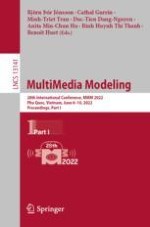2022 | Book
MultiMedia Modeling
28th International Conference, MMM 2022, Phu Quoc, Vietnam, June 6–10, 2022, Proceedings, Part I
Editors: Björn Þór Jónsson, Cathal Gurrin, Minh-Triet Tran, Duc-Tien Dang-Nguyen, Anita Min-Chun Hu, Binh Huynh Thi Thanh, Benoit Huet
Publisher: Springer International Publishing
Book Series : Lecture Notes in Computer Science
